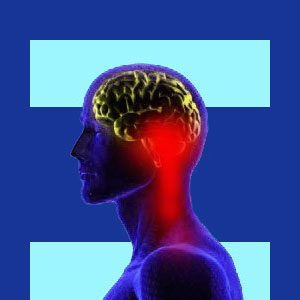
Neck pain behind ear is a common patient complaint that describes discomfort in back of the ear on one side of the head or both. This type of pain can come from several possible sources and is often a chronic problem for some unlucky patients. Since this region contains the ear structure itself, major nerves, muscles and blood vessels, pinpointing the exact causation of recurrent symptoms can be a frustrating process.
This essay delves into unilateral and bilateral pain behind the ear and explores the possible causes of this symptom set. We will investigate cervical spinal causations, as well as infectious processes in the ear, ischemic processes, headache processes and nerve dysfunction as potential explanations for the pain.
Neurological Neck Pain Behind Ear
Pain that exists behind the ear can come about from nerve disease or a neurological compression syndrome. The head is rich in neurological tissues and several nerves transverse the region behind the ear. Nerves can suffer structural compression, disease or ischemia and all of these processes can cause pain or symptomatic dysfunction to occur.
Some of the possible causes of structural neurological issues behind the ear include pinched nerves in the upper cervical spine, usually at C2, or nerves that suffer compression by some non-spinal source, such as a by a muscle, tendon or ligament, after they exit the spinal anatomy.
Ischemia can cause nerves to function incorrectly, resulting in acute or chronic symptoms. This oxygen deprivation syndrome can be anatomically-enacted or psychogenic in nature.
Some of the common diagnostic conclusions associated with neurological pain behind the ear include occipital neuralgia, cervical plexus syndrome or posterior auricular pain.
Muscular Pain Behind Ear
The soft tissues of the head anatomy can also experience or cause pain behind the ear structure. These types of agonizing conditions might be related to injury, such as minor strain, sprain or whiplash.
The mastoid process is the small bony prominence located behind each ear. This structure is a major point of connection for many soft tissue structures that can suffer any number of traumas, ranging from small tears to full detachment.
Muscular, ligamentous and tendon-related pain can also occur as a result of a greater tension-type headache process. Tension headaches are a major chronic concern for many patients. These scenarios often occur due to regional oxygen deprivation of the scalp muscles and other soft tissues.
Cervical headaches can also be experienced due to structural concerns in the upper spine that influence the entire surrounding nerve and muscle anatomy.
Experiencing pain in the rear of the ear is a very common location for both types of headache expressions to exist.
Myofascial pain syndrome can create a miserable sensation behind the ear and is often linked to idiopathic fascial and muscular tissue abnormalities.
Alternate Explanations for Neck Pain Behind Ear
Although the patient may perceive the pain to be in their neck, in many cases, the symptoms reside deep inside the ear canal, instead. Inner ear problems are also common and can be very painful in some circumstances.
Tumors can grow inside the inner ear anatomy and might cause severe pain, especially in the case of acoustic neuromas. These are growths that actually form on the neurological tissue of the ear.
Ear infections, such as otitis media, can cause deep pain that might feel like the symptoms are radiating from behind the ear. Likewise, regional infections of the throat can also sometimes cause similar symptomatic expressions, especially in cases of pharyngitis or tonsillitis. Mastoiditis describes an infection in that same small bone located behind the ear. This is a syndrome most often seen in children.
Styloid–carotid artery syndrome is a rare condition that is caused by a longer than typical styloid process.
Temporomandibular joint dysfunction can enact pain at the upper corner of the jaw. This pain often feels like it is coming from the rear side of the head, deep in the neck anatomy behind the ear.
Pain Behind Ear Summation
The most common cause of recurrent rear ear neck pain is certainly tension-style headaches. These conditions are often linked to a mindbody causation and can often be treated successfully using psychoemotional therapies. It is a shame that so many patients turn to pharmaceutical headache treatment, since this therapy path is purely symptomatic in nature and can be dangerous to general health and wellness.
The second most common cause of pain behind the ear is certainly neurological dysfunction, often related to a muscular compression or spinal compression neuropathy.
Other causations are certainly plausible, but usually entail other symptoms that denote their true nature as being syndromes that are not classically characterized as true neck pain issues. For more information or proper diagnostic evaluation, please consult with a qualified physician.
Neck Pain > Cervical Pain > Neck Pain Behind Ear






